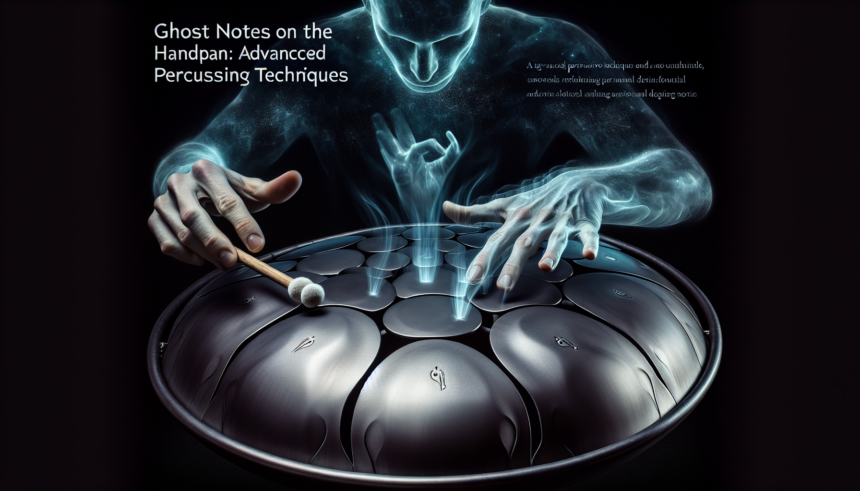<!DOCTYPE html>
<html lang="en">
<head>
<meta charset="UTF-8">
<meta name="viewport" content="width=device-width, initial-scale=1.0">
<title>Ghost Notes on the Handpan</title>
</head>
<body>
<p>The handpan is a captivating instrument that mesmerizes musicians and audiences alike with its soothing, ethereal sounds. While many enjoy exploring its harmonic richness through melodic playing, delving into advanced percussive techniques can unlock a whole new dimension of expressive potential. One such technique is the use of ghost notes. In this guide, we will explore what ghost notes are, how to play them, and how they can be incorporated into your handpan performances to add texture, rhythm, and subtle complexity.</p>
<h2>Understanding Ghost Notes</h2>
<p>In musical terminology, ghost notes are notes that are perceived as softer and less prominent than the main notes in a rhythm or melody. They are often used in various percussive instruments, such as drums, to add a layer of intrigue and nuance. On the handpan, ghost notes can serve a similar purpose, introducing delicate rhythmic pulses that enhance the overall texture of a piece without drawing too much attention.</p>
<h2>Why Use Ghost Notes on the Handpan?</h2>
<p>Ghost notes inject subtlety and depth into music. For handpan players seeking to expand their sonic palette, learning how to use ghost notes can be transformative. These understated notes can create a dynamic interplay between louder tones and softer accents, giving rise to rhythmic patterns that breathe life into performances. Moreover, ghost notes can seamlessly blend into complex finger techniques, making your playing more evocative and engaging.</p>
<h2>Technique and Execution</h2>
<p>Playing ghost notes on the handpan requires a delicate balance of touch and timing. They are typically executed by striking the instrument with less force, producing a muted sound that is less resonant compared to the primary notes. Here are some steps to incorporate ghost notes into your playing:</p>
<h3>1. Hand and Finger Positioning</h3>
<p>Proper hand positioning is crucial when playing ghost notes. Maintain relaxed hands and keep your fingers slightly curved. Use the pads of your fingers for gentle strikes, allowing for softer contact with the surface of the handpan.</p>
<h3>2. Control of Dynamics</h3>
<p>Experiment with the dynamics by adjusting the velocity of your strikes. Start by practicing simple patterns alternating between ghost notes and regular notes to gain better control over your handpan’s dynamic range.</p>
<h3>3. Integrating with Rhythmic Patterns</h3>
<p>To effectively incorporate ghost notes, practice exercises with specific rhythmic patterns. For instance, you can alternate ghost notes between stronger beats in a measure to create an intricate interplay between dominant and subtle accents.</p>
<h3>4. Enhance with Tape and Brushes</h3>
<p>To refine the ghost note effect, some handpan players use tape or brushes for a more muted sound. Experimenting with different materials can help craft a distinctive style that complements your playing.</p>
<h2>Applying Ghost Notes in Musical Contexts</h2>
<p>Once you are comfortable with ghost notes, start integrating them into your compositions. Whether you are performing solo or collaborating with other musicians, ghost notes can add dimension to various musical contexts:</p>
<h3>1. Polyrhythmic Layers</h3>
<p>Create polyrhythms by layering ghost notes over existing melodies, gently weaving them into the main rhythm to form intricate percussive textures. This technique enhances the complexity of your music.</p>
<h3>2. Groove Development</h3>
<p>Incorporate ghost notes into grooves to develop evolving patterns that build anticipation and momentum. Their subtle presence can make repetitive sequences more engaging and hypnotic.</p>
<h3>3. Expressive Solos</h3>
<p>During improvised solos, ghost notes can be used to punctuate phrases with understated elegance. These notes can serve as gentle transitions, creating a flowing narrative within your solos.</p>
<h2>Tips for Practice and Mastery</h2>
<p>To master ghost notes, consistent practice is key. Here are some tips to guide your practice sessions:</p>
<h3>1. Slow Practice</h3>
<p>Start at a slower tempo to hone accuracy and control. Gradually increase the speed, ensuring that the ghost notes maintain their refined quality.</p>
<h3>2. Listening and Imitating</h3>
<p>Listen to skilled handpan players who utilize ghost notes adeptly. Analyze their techniques and try to replicate their style while adding your own unique flair.</p>
<h3>3. Record and Review</h3>
<p>Record your practice sessions to evaluate your progress. Listening to your recordings will help you identify areas for improvement and ensure a balanced use of ghost notes.</p>
<h2>Conclusion</h2>
<p>Ghost notes on the handpan are subtle yet powerful tools that can dramatically enhance your playing. By mastering the technique, you add nuance and complexity to your music, enriching the listener’s experience. Whether creating delicate rhythmic textures or boosting your expressive range, the integration of ghost notes redefines how percussive elements can evolve on the handpan. Through diligent practice and creative experimentation, handpan players of all levels can unlock the full potential of this mesmerizing instrument.</p>
<h2>FAQs</h2>
<h3>1. What are ghost notes on the handpan?</h3>
<p>Ghost notes on the handpan are soft, muted notes played with minimal force, adding subtlety and texture to the music without dominating the soundscape.</p>
<h3>2. How can I practice using ghost notes effectively?</h3>
<p>Start by practicing simple rhythmic patterns, alternating between ghost notes and regular notes. Gradually integrate them into more complex patterns and compositions to develop control and subtlety.</p>
<h3>3. Are ghost notes suitable for all handpan compositions?</h3>
<p>While not essential for every composition, ghost notes can enhance many musical contexts. They are particularly effective in adding depth to polyrhythms, developing grooves, and enriching solos.</p>
<h3>4. Can I use ghost notes in a live performance?</h3>
<p>Yes, ghost notes are well-suited for live performances. Their subtlety can captivate audiences, adding a layer of sophistication and intricacy to your music.</p>
<h3>5. Do ghost notes require specialized techniques or equipment?</h3>
<p>Ghost notes primarily rely on technique, such as touch and dynamics. However, some players use materials like tape or brushes to achieve specific muted effects, enhancing the ghost note sound.</p>
</body>
</html>Ghost Notes on the Handpan: A Guide to Advanced Percussive Techniques

Leave a comment




